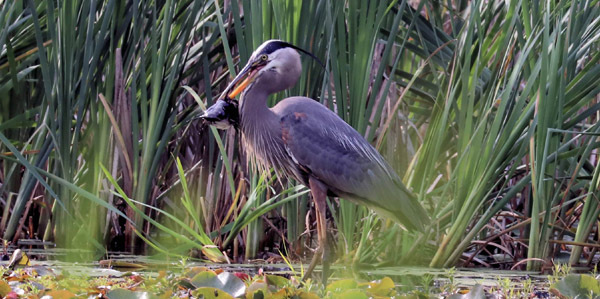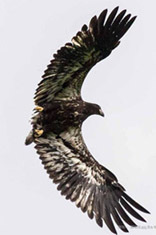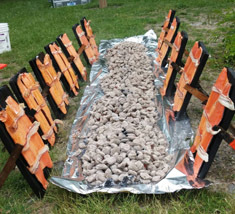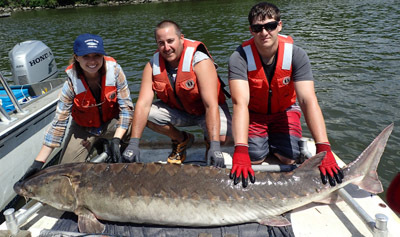Hudson River Almanac 6/9/18 - 6/15/18
The New York State Department of Environmental Conservation sent this bulletin on 06/22/2018 02:00 PM EDT |
| DEC Delivers - Information to keep you connected and informed from the NYS Department of Environmental Conservation |
| Share or view as a web page || Update preferences or unsubscribe |
|
|
OVERVIEW Huge Atlantic sturgeon up to nine-feet-long – the largest fish that regularly swims in the Hudson River – were now spawning. That, in itself, is a reaffirmation of the river’s viability. In the uplands, we had a visit from a rare songbird that is more likely to be found in the southern Great Plains. HIGHLIGHT OF THE WEEK
[The scissor-tailed flycatcher (Tyrannus forficatus), also known as the Texas Bird-of-Paradise, as well as being the state bird of Oklahoma, is a rare stray to the Hudson Valley. While it is most often found in the southern Great Plains, Stan DeOrsey adds that scissor-tailed flycatchers are known wanderers. They have been reported from every state (except Hawaii, not sure about Alaska). There are three reports in Dutchess County, none confirmed or photographed. They may stay a day or two but usually are one-day wonders! Steve Chorvas adds that the scissor-tailed flycatcher is listed on the John Burroughs Birds of Ulster County as rare with the last documented record occurring in August 2008 from the Shawangunk Grasslands National Wildlife Refuge in southern Ulster County. The next most recent was July 1989. Tom Lake] NATURAL HISTORY ENTRIES 6/9 – HRM 302-0: I led a just-concluded Hudson River Watershed Ecology field course (5/31-6/5) for eight PhD students from the Department of Aquatic Resources, Swedish University of Agricultural Sciences, as well as one of my ESF doctoral students, a young woman from Iran. There were five nations represented: Sweden, Holland, Italy, Iran, and the U.S. Our journey began in Essex County (river mile 320) and culminated at the Battery in Manhattan (river mile zero). Highlights: – Newcomb, HRM 302: We entered the watershed at Newcomb at the Adirondack Ecology Center. We went to Arbutus and Rich lakes to check pre-set gill nets, but they were empty. We were not surprised since these lakes appear to have lost fish in recent years (see my Almanac observations in September 2015). We measured a few water quality parameters in Rich Lake finding dissolved oxygen (DO) at 7.66 mg/L, 84.2 % saturation and specific conductance: 37.1 microSiemens/cm2 - pH: 6.45. To me, the conductance is the most meaningful parameter to measure along the Hudson River gradient. The next day we did an early morning hike along the shore of Arbutus Lake up to the main inlet stream. This has been monitored since the early 1980s for biogeochemical analysis, but the lake itself is sparsely studied ecologically (and thus we don’t understand why it has lost its fish). – Troy, HRM 153: We transited southward to Troy and met Scott Wells, fisheries biologist from DEC Region 4 where we went electro-fishing below the federal dam at Troy. Freshwater drum were spawning and topped the list in terms of numbers and sheer biomass. We found numerous redhorse [suckers], a few white suckers, both large and smallmouth bass, bluegill, redbreast sunfish, channel catfish, and brown bullhead. We also caught two other species that I had never seen in the estuary: a 450 millimeter (mm) northern pike and a northern hogsucker. American shad, American eels, and striped bass were the only diadromous species that we encountered. Water conditions included 73 degrees Fahrenheit (F), specific conductance 235 microS/cm2; salinity 0.11 parts-per-thousand (ppt), DO 8.25 mg/L with the water 96% DO saturated. [Note: one inch = 25.4 millimeters (mm)] – Westchester County, HRM 38.5: We electro-fished a small run of Furnace Brook below a dam, a few hundred feet from the river, that is slated for removal. We found abundant aquatic life, including native spiny-cheeked crayfish, brown bullheads, common shiners, tessellated darters, bluegills, redbreast sunfish, and American eels.
[Each spring we agonize over eggs hatching, nestlings surviving, and fledglings adapting to their new world. Bald eagles are, on one hand, quite fragile, yet they also show much resiliency. The sorting out of who lives and who does not, is in their genes. It seems arbitrary to us, at times, but since they have been at this long before we were around, we can be confident that they are getting it right. Tom Lake] 6/9 – Croton-on-Hudson, HRM 35: I watched a great blue heron this morning at the Brinton Brook Wildlife Sanctuary. The bird remained motionless for ten minutes, then turned its head slightly to one side and struck like lightning at a 2-pound brown bullhead. The heron speared the fish and began carrying it toward a shallower area, but when it saw me, it dropped the fish. The heron then grabbed it with a better grip and flew off, disappearing into the tall vegetation. 6/9 – Bedford, HRM 35: The great blue heron rookery nestlings continued to grow and look more like their parents. Their routine was to wait patiently for their next meal to arrive, often seen with their heads stretched straight up scanning the sky. When the adults arrive, there is a great deal of excitement as the nestlings eagerly look for their share. 6/10 – Schodack Creek, HRM 136: I wanted to scout out conditions at Schodack Creek prior to an upcoming Hudson River National Estuarine Research Reserve public canoe trip. I put in at the canoe-kayak launch at Schodack Island State Park and headed south where I found two surprises. Two adult eagles were having a spirited conversation, and when I looked in the direction of their chatter, I realized they were perched near their nest where I could see the head of a nestling peeking out. My second surprise was finding a fragrant and lovely Wisteria bush along the shoreline with its blooms not yet in total splendor. I wondered how far the escaped seed pods had traveled before they found this fertile ground.
6/10 – Beacon, HRM 61: This was our thirty-fourth year of Hudson River Foundation-sponsored “shad bakes” along the Hudson River, featuring smoked and baked fish, discussions on estuarine ecology, and reconnecting people to their river. Our American shad fishery was closed in 2010 due to the effects of over-harvesting. Presently, a coast-wide species recovery plan is in effect. Twenty-five years ago, we used to run 13 shad bakes each spring. As a result of the closure, we now plank (baked on 100-year-old white oak planks) and smoke steelhead (rainbow) trout, marinated in several ingredients, including Hudson Valley maple syrup.(Photo of baking steelhead trout on 100 year old oak planks courtesy of Tom Lake) Today, we were at Pete and Toshi Seeger Park as part of the Beacon Sloop Club’s Strawberry Festival where the smell of wood smoke and the sweet texture of the golden finished fillets were all a part of springtime. We invited hundreds of festival-goers for free samples of our savory fish, and more than 550 dishes were given out. [The Hudson River shad bake has its historical origins in Colonial times. Other than keeping a wary eye for British warships, commercial shad fishing was hardly disrupted by the American Revolution. Europeans had been introduced to American shad by the indigenous Algonquian people who lived along the estuary. For many millennia, they had celebrated the annual return of fish from the sea by baking them on huge riverside roasting platforms, some of which were a half-acre in size. Fires, hot coals and cobbles were set around flat rocks, upon which shad and other fish were placed for slow cooking and smoking. We have always wondered if they saw this as a festive occasion, with song, dance, and laughter. How could they not? Tom Lake]
6/11 – Manhattan, HRM 1: We checked our research sampling gear in Hudson River Park at The River Project's sampling station on the lighthouse tender Lilac at Pier 25 and found that our pots and traps had caught two handsome oyster toadfish (215, 220 mm), a tautog (225 mm), and a delightful skilletfish (55 mm). [Skilletfish (Gobiesox strumosus) are a small benthos-loving fish somewhat related to gobies and blennies. They find oyster reefs ideal habitat for both forage and safety. Their name comes from a dorsally-flattened body with a large, roundish head that altogether looks like a skillet. Tom Lake] 6/12 – Town of Poughkeepsie: There was some “wing flapping” in bald eagle nest NY62 today by the two hungry fledglings. Although they are free to fly, they remembered where the food was provided, and it will take them both a while, and some parental urging, for them to find food elsewhere. 6/12 – Manhattan, HRM 1: We checked our research sampling gear in Hudson River Park at The River Project's sampling station on the lighthouse tender Lilac at Pier 25 and were treated to a tiny lined seahorse (55 mm). 6/13 – Bedford, HRM 35: There was a whole-lot of clackin’ going on at the great blue heron rookery today. There were many nestlings and juveniles crowding several nests, including at least a dozen young birds of various sizes. 6/13 – Manhattan, HRM 1: We checked our research sampling gear in Hudson River Park at The River Project's sampling station on the lighthouse tender Lilac at Pier 25 and found that we had captured an impressive tautog (255 mm). [Tautog, or blackfish (Tautoga onitis), are a coal-black saltwater wrasse, a fish of New England waters and the Mid-Atlantic Bight. Their common name as well as species name is derived from an extinct Algonquian language formerly spoken by Narragansett Indians in Rhode Island and vicinity. Another colloquial name, “sheepshead,” speaks to the blocky-shape of their head. Tom Lake] 6/14 – Cold Spring, HRM 55: A strong northwest wind blowing downriver into the flood current – wind against tide – had the river capped-over in swells and white froth. Despite the demanding conditions, Krista Norris and the crew of the Hudson River sloop Clearwater towed their otter trawl for 7th grade students from George Fischer Middle School in Carmel. Among the fishes they caught were white perch, young-of-the-year (YOY) Atlantic tomcod, the largest of which was 85 mm, and a surprise white catfish (170 mm). By far the majority of catfish caught in the mid-Hudson reach are nonnative channel catfish. [An otter trawl is a net used by researchers, educators, and commercial fisheries to capture aquatic life. The net is generally pulled behind a vessel under way, operating much like a seine hauled along a beach. The trawl has a bag, called the “cod end,” where fish collect. The sides of the net are held open by pressure exerted on two rectangular boards, “doors”, one on either side. The depth it fishes can be regulated depending on the speed of the vessel and how much line is played out, called the “scope.” As the scope increases – the distance between the vessel and the otter trawl – the net fishes deeper. Tom Lake]
[There is a subspecies of the eastern chipmunk called “gray chipmunk” (Tamias striatus griseus). Its range appears to be the upper Midwest. Was this individual one of them? My best guess is that this handsome gray chipmunk is a genetic color variant. But that is only a guess. Erik Kiviat] 6/15 – Milford, PA: I spoke with the Delaware Valley Raptor Center today. The two bald eagle nestlings transported there on May 16 were doing fine. The injured bird had surgery on its leg and was now healing. The center told me that both eagles will be released when they feel they are ready. I will check back in another month. - Mauricette Char Potthast [On May 15, high winds from a massive storm, that included tornados, destroyed bald eagle nest (NY459A) in the Town of Wappinger. A pair of 42-day-old nestlings had fallen 75 feet to the ground. The next day a rescue operation was undertaken by Annie Mardiney, Meghan Oberkircher, and Mauricette Char Potthast. One of the nestlings was uninjured; the other had a broken leg. Both nestlings were taken to the Delaware Valley Raptor Center in Milford, PA. Tom Lake] 6/15 – Yonkers, HRM 18: Eager, excited students from BSA Scouts Pack 333 came to the Sarah Lawrence Center for the Urban River at Beczak to help us sample the river. We began seining at low tide in late afternoon; some of the Scouts had experience which added to their enjoyment. After only a few hauls, we had an exciting collection of river life: three American eels, two Atlantic tomcod, six white perch, three blue crabs, and 40 shore shrimp. 6/15 – Manhattan, HRM 1: We checked our research sampling gear in Hudson River Park at The River Project's sampling station on the lighthouse tender Lilac at Pier 25. In one of our traps we found two adorable 45 mm oyster toadfish!
Free Trees for Streamside Planting For more information about the program or to download an application, please visit the DEC website at: www.dec.ny.gov/lands/43668.html . If you have questions about a potential planting site, please contact Beth Roessler at (845) 256-2253 or HudsonEstuaryTFT@dec.ny.gov. The Hudson is measured north from Hudson River Mile 0 at the Battery at the southern tip of Manhattan. The George Washington Bridge is at HRM 12, the Tappan Zee 28, Bear Mountain 47, Beacon-Newburgh 62, Mid-Hudson 75, Kingston-Rhinecliff 95, Rip Van Winkle 114, and the Federal Dam at Troy, the head of tidewater, at 153. The tidal section of the Hudson constitutes a bit less than half the total distance – 315 miles – from Lake Tear of the Clouds to the Battery. Entries from points east and west in the watershed reference the corresponding river mile on the mainstem. TO CONTRIBUTE YOUR OBSERVATIONS OR TO SUBSCRIBE The Hudson River Almanac is compiled and edited by Tom Lake and emailed weekly by DEC's Hudson River Estuary Program. Share your observations by e-mailing them to trlake7@aol.com. To subscribe to the Almanac (or to unsubscribe), use the links on DEC's Hudson River Almanac or DEC Delivers web pages. Discover New York State Conservationist - the award-winning, advertisement-free magazine focusing on New York State's great outdoors and natural resources. Conservationist features stunning photography, informative articles and around-the-state coverage. Visit the Conservationist webpage for more information. USEFUL LINKS National Oceanic and Atmospheric Administration online tide and tidal current predictions are invaluable when planning Hudson River field trips. For real-time information on Hudson River tides, weather and water conditions from sixteen monitoring stations, visit the Hudson River Environmental Conditions Observing System website. NY Open for Hunting and Fishing Initiative: Under Governor Cuomo's Adventure NY initiative, DEC is making strategic investments to expand access to healthy, active outdoor recreation, connect more New Yorkers and visitors to nature and the outdoors, protect natural resources, and boost local economies. This initiative will support the completion of more than 75 projects over the next three years, ranging from improvements to youth camps and environmental education centers to new boat launches, duck blinds, and hiking trails. Read more about the Adventure NY initiative. For more information on planning an outdoor adventure in New York State, visit DEC's website at http://www.dec.ny.gov/outdoor. Information about the Hudson River Estuary Program is available on DEC's website at http://www.dec.ny.gov/lands/4920.html. Copies of past issues of the Hudson River Almanac, Volumes II-VIII, are available for purchase from the publisher, Purple Mountain Press, (800) 325-2665, or email purple@catskill.net |

 Hudson River Almanac
Hudson River Almanac 6/12 – Town of Esopus, HRM 87: A scissor-tailed flycatcher, with an extremely long and scissor-like tail, was spotted and photographed today by Joel Meier. Despite much searching, the bird could not be relocated. Photographs confirmed the identification. (Photo of scissor-tailed flycatcher courtesy of Joel Meier)
6/12 – Town of Esopus, HRM 87: A scissor-tailed flycatcher, with an extremely long and scissor-like tail, was spotted and photographed today by Joel Meier. Despite much searching, the bird could not be relocated. Photographs confirmed the identification. (Photo of scissor-tailed flycatcher courtesy of Joel Meier) 6/9 – Town of Poughkeepsie: This was the first day that we knew, conclusively, that both nestlings had fledged from bald eagle nest NY62. We could see both of them flying around in the field below the nest tree. Before today, we were not sure if we were seeing the same bird fly at different times, or if both were flying. (Photo of bald eagle fledgling courtesy of Bob Rightmyer)
6/9 – Town of Poughkeepsie: This was the first day that we knew, conclusively, that both nestlings had fledged from bald eagle nest NY62. We could see both of them flying around in the field below the nest tree. Before today, we were not sure if we were seeing the same bird fly at different times, or if both were flying. (Photo of bald eagle fledgling courtesy of Bob Rightmyer) 6/10 – Town of New Paltz, HRM 78: I came upon a nesting pair of red-headed woodpeckers at Weston Swamp. The nest hole was nicely positioned for viewing facing Weston Road, and the nestlings seemed very young. As I watched, the adults switched places with one bringing food to the nest. (Photo of red-headed woodpecker courtesy Deborah Tracy-Kral)
6/10 – Town of New Paltz, HRM 78: I came upon a nesting pair of red-headed woodpeckers at Weston Swamp. The nest hole was nicely positioned for viewing facing Weston Road, and the nestlings seemed very young. As I watched, the adults switched places with one bringing food to the nest. (Photo of red-headed woodpecker courtesy Deborah Tracy-Kral)
 6/11 – Crum Elbow, HRM 82: We caught a 6.5-foot-long, 187-pound female Atlantic sturgeon in our research net today. She was spawning – her eggs (caviar) were running – reconfirming this area as a spawning ground for her species (Acipenser oxyrinchus). In twelve years of catching adult Atlantic sturgeon in the river, this was only the second individual we caught that was actively spawning. Our sturgeon are collected, photographed, tagged, and released under Federal Permit 20340. (Photo of Atlantic sturgeon collected under NMFS permit 20340 courtesy of Amanda Higgs)
6/11 – Crum Elbow, HRM 82: We caught a 6.5-foot-long, 187-pound female Atlantic sturgeon in our research net today. She was spawning – her eggs (caviar) were running – reconfirming this area as a spawning ground for her species (Acipenser oxyrinchus). In twelve years of catching adult Atlantic sturgeon in the river, this was only the second individual we caught that was actively spawning. Our sturgeon are collected, photographed, tagged, and released under Federal Permit 20340. (Photo of Atlantic sturgeon collected under NMFS permit 20340 courtesy of Amanda Higgs) 6/15 – Clarksville, HRM 141: I live in the Helderberg Mountains of Albany County and the water from my land flows into the Hudson River. While I regularly see many chipmunks in my area, all of them with the usual coloring of their fur, today I came upon a gray chipmunk. I had never seen one like this before and I wonder if anyone else has. (Photo of gray chipmunk courtesy of Fred Fiato)
6/15 – Clarksville, HRM 141: I live in the Helderberg Mountains of Albany County and the water from my land flows into the Hudson River. While I regularly see many chipmunks in my area, all of them with the usual coloring of their fur, today I came upon a gray chipmunk. I had never seen one like this before and I wonder if anyone else has. (Photo of gray chipmunk courtesy of Fred Fiato)